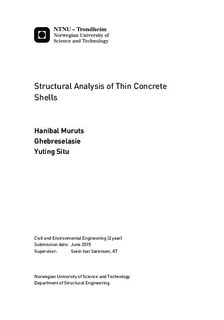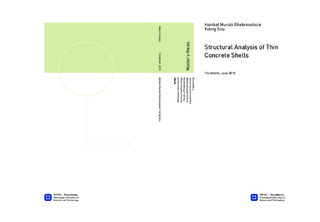| dc.description.abstract | From the perspective of structural engineering, shells due to their spatial curvature, possess
a structurally efficient way of carrying loads acting perpendicular to their surfaces.
However, the nature and geometry of shells makes them complicated to understand or
predict their structural behaviour. The structural analysis of thin concrete shells can
be conducted numerically using finite element analysis(FEA) or/and analytically on the
basis of classical theory of thin shells. As finite element software are increasingly becoming
primary tools for performing structural analysis, the knowledge of the analytical
solution methods are becoming somehow less known among young structural engineers
today. Hence, this paper aims to revisit the analytical analysis methods for concrete shell
structures, and to investigate on how its results compare to that of the FEA. For a complete
investigation of the structural analysis of thin concrete shells, the design and the
accompanying verification by using nonlinear FEA is also briefly included. The study is
limited to structural static analysis.
A combination of both a brief review of the theoretical background and a number of illustrative
numerical examples are used as the basis for this study. Both the theory and
the examples are focused on some of the most commonly build concrete shell structures,
i.e axisymmetric shells and cylindrical shell roofs. Structural parts such as ring beams
and circular plates, which are normally associated with concrete shell structures are also
included. The finite element analysis of the structures is the numerical examples are performed
in a finite element software called DIANA. Following the linear FEA, some of the
structures in the numerical examples are designed accordingly, and analysed using nonlinear
FEA. The nonlinear FEA are performed with the main focus on material utilization
and verification of the load carrying capacity. Both the design and load calculations are
done on the basis of the Eurocodes.
In most of the numerical examples considered in this study, a relatively good agreement
between the solutions obtained from the FEA and the analytical method is found. In the
last example, where a simply supported circular cylindrical shell roof is considered, the
solutions from the FEA has shown some deviation of varying magnitude compared to the
analytical solutions. Some of the possible sources of this deviation concerning assumptions
and mesh density are discussed. The nonlinear FEA of the selected RC structures show
that all the considered structures has the necessary capacity to carry the applied loading.
Moreover the stress concentrations and crack patterns are relatively as one could expect
on the basis of the linear FEA.
Following this study it can be concluded that the analytical solution method provides
a relatively safe and independent way of verifying the results obtained from the FEA.
Moreover it provides a valuable insight into the structural behaviour of shells, which is
vital for objectively evaluating the accuracy of results obtained from FEA of any shell
structure. The computations involved in the analytical solution procedure of concrete
shell structures is however long and complicated thus it is highly exposed to calculation
errors. To avoid this errors it is advisable for structural engineers to make a script,
spreadsheet or a simple software that is based on the analytical method.
iii | |

